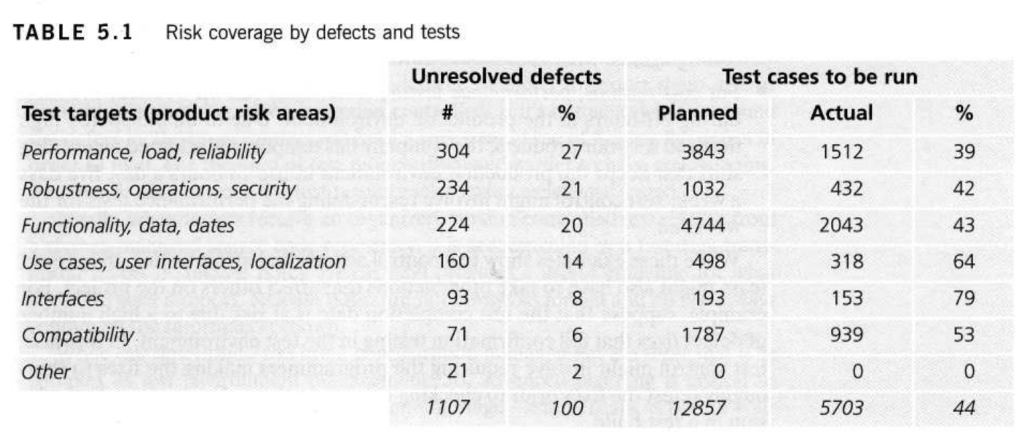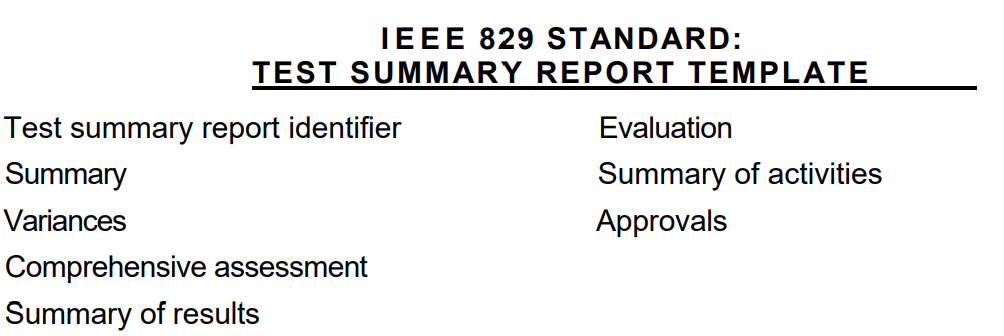5.3.2 Reporting test status
Test progress monitoring is about gathering detailed test data; reporting test status is about effectively communicating our findings to other project stakeholders. As with test progress monitoring, in practice there is wide variability observed in how people report test status, with the variations driven by the preferences of the testers and stakeholders, the needs and goals of the project, regulatory requirements, time and money constraints and limitations of the tools available for test status reporting.
Often variations or summaries of the metrics used for test progress monitoring, such as Figure 5.1 and Figure 5.2, are used for test status reporting, too. Regardless of the specific metrics, charts and reports used, test status reporting is about helping project stakeholders understand the results of a test period, especially as it relates to key project goals and whether (or when) exit criteria were satisfied.
In addition to notifying project stakeholders about test results, test status reporting is often about enlightening and influencing them. This involves analyzing the information and metrics available to support conclusions, recommendations, and decisions about how to guide the project forward or to take other actions. For example, we might estimate the number of defects remaining to be discovered, present the costs and benefits of delaying a release date to allow for further testing, assess the remaining product and project risks and offer an opinion on the confidence the stakeholders should have in the quality of the system under test.
You should think about test status reporting during the test planning and preparation periods, since you will often need to collect specific metrics during and at the end of a test period to generate the test status reports in an effective and efficient fashion. The specific data you’ll want to gather will depend on your specific reports, but common considerations include the following:
- How will you assess the adequacy of the test objectives for a given test level and whether those objectives were achieved?
- How will you assess the adequacy of the test approaches taken and whether they support the achievement of the project’s testing goals?
- How will you assess the effectiveness of the testing with respect to these objectives and approaches?
For example, if you are doing risk-based testing, one main test objective is to subject the important product risks to the appropriate extent of testing. Table 5.1 shows an example of a chart that would allow you to report your test coverage and unresolved defects against the main product risk areas you identified in your risk analysis. If you are doing requirements-based testing, you could measure coverage in terms of requirements or functional areas instead of risks.
On some projects, the test team must create a test summary report. Such a report, created either at a key milestone or at the end of a test level, describes the results of a given level or phase of testing. The IEEE 829 Standard Test

Summary Report Template provides a useful guideline for what goes into such a report. In addition to including the kind of charts and tables shown earlier, you might discuss important events (especially problematic ones) that occurred during testing, the objectives of testing and whether they were achieved, the test strategy followed and how well it worked, and the overall effectiveness of the test effort.

5.3.3 Test control
Projects do not always unfold as planned. In fact, any human endeavor more complicated than a family picnic is likely to vary from plan. Risks become occurrences. Stakeholder needs evolve. The world around us changes. When plans and reality diverge, we must act to bring the project back under control.
In some cases, the test findings themselves are behind the divergence; for example, suppose the quality of the test items proves unacceptably bad and delays test progress. In other cases, testing is affected by outside events; for example, testing can be delayed when the test items show up late or the test environment is unavailable. Test control is about guiding and corrective actions to try to achieve the best possible outcome for the project.
The specific corrective or guiding actions depend, of course, on what we are trying to control. Consider the following hypothetical examples:
- A portion of the software under test will be delivered late, after the planned test start date. Market conditions dictate that we cannot change the release date. Test control might involve re-prioritizing the tests so that we start testing against what is available now.
- For cost reasons, performance testing is normally run on weekday evenings during off-hours in the production environment. Due to unanticipated high demand for your products, the company has temporarily adopted an evening shift that keeps the production environment in use 18 hours a day, five days a week. Test control might involve rescheduling the performance tests for the weekend.
While these examples show test control actions that affect testing, the project team might also have to take other actions that affect others on the project. For example, suppose that the test completion date is at risk due to a high number of defect fixes that fail confirmation testing in the test environment. In this case, test control might involve requiring the programmers making the fixes to thoroughly retest the fixes prior to checking them in to the code repository for inclusion in a test build.
